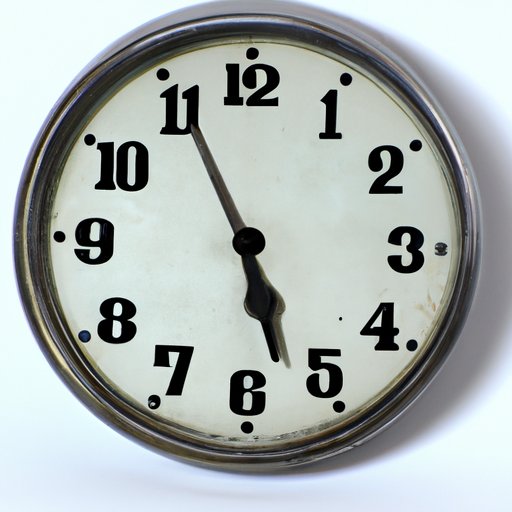I. Introduction
For many people, telling time in military time can be a challenge. With the 24-hour clock format, it can feel like you’re speaking a different language. However, military time serves a critical function for certain professions and offers practical benefits for everyday use. This guide aims to help readers understand and use military time confidently and efficiently.
II. A Beginner’s Guide to Military Time: Understanding the 24-Hour Clock
Military time, also known as the 24-hour clock, is a time system that uses numbers from 00:00 (midnight) to 23:59 (11:59 pm) to represent the hours in a day. While the standard time format uses a 12-hour clock that repeats itself twice a day, military time represents each hour only once in a day.
The use of military time eliminates the ambiguity that can arise with standard time when referring to a.m. or p.m. hours. For example, “2 a.m.” and “2 p.m.” can be easily confused, especially in a 12-hour format. With military time, however, there is no confusion – the times are represented as either 0200 or 1400, respectively.
The benefits of military time include clearer communication and greater precision in scheduling. In many professions, such as the military, aviation, or healthcare, accuracy and clarity are critical. The use of military time reduces the risk of confusion and errors, ensuring that everyone understands the time and can coordinate accordingly.
III. Why Military Time Matters: The Practical Benefits of Using 24-Hour Time
The use of military time is crucial in many fields and industries, where precise timing and coordination are paramount. For example, in the military, using the 24-hour clock enables personnel to coordinate worldwide operations, regardless of location or time zones.
Similarly, in the aviation industry, pilots and air traffic controllers rely on military time to ensure safe and efficient flights. Using standard time could lead to confusion and errors, which could have serious consequences. Military time is also widely used in the healthcare industry, where scheduling and medication administration require accurate timing.
Besides its role in these critical professions, military time also offers practical benefits for everyday use. For example, it eliminates the need to specify whether the time is a.m. or p.m., making it easier to read schedules, calendars, and other time-related documents.
IV. Making the Switch to Military Time: Tips for Transitioning to a New Time System
If you’re used to standard time, transitioning to military time may seem daunting at first. However, with a little practice, it becomes easy and intuitive. Experts recommend that you start by using military time for a few days and increase gradually until you feel comfortable.
You can also practice converting standard time to military time and vice versa until you can do it quickly and accurately. There are many online tools and apps to help with this, as well as printable conversion charts. By practicing regularly, you’ll soon be able to read and use military time like a pro.
V. Mastering Military Time: Common Conversions and Timekeeping Practices
Converting military time to standard time and vice versa requires a bit of practice and familiarity with the 24-hour clock format. Here are some tips to help:
- For military time to standard time conversions, subtract 12 from any hour after noon and add “p.m.” For example, 1500 becomes 3 p.m.
- For standard time to military time conversions, add 12 to any hour past noon and omit “a.m.” or “p.m.” For example, 9 p.m. becomes 2100.
- Remember to observe the leading zeros before the hour, such as 0500 instead of 500.
When using military time, it’s important to keep in mind that the day starts at midnight, represented by 0000, rather than 12 a.m. In addition, the format of the time is always in four digits (e.g., 0400, 1330, 2200), with the first two digits representing the hour and the last two digits representing the minutes.
VI. The History of Military Time: How the 24-Hour Clock Became a Global Standard
The use of the 24-hour clock format can be traced back to ancient civilizations such as the Egyptians, who measured time based on the movement of the sun. However, the modern 24-hour clock system was developed by the Egyptians and later adopted by the military, which used it to coordinate troop movements and operations.
Today, military time is used as a global standard in many industries, especially those that require precise timing and communication. The adoption of military time has also been driven by the need for standardization and coordination in a globalized world, where people from different time zones and cultures need to work together seamlessly.
VII. Breaking Down Military Time: Demystifying the Differences Between AM and PM
In military time, there is no need to specify whether the time is a.m. or p.m., as it is always clear from the format of the time. However, it’s essential to understand the conversion from standard time to military time to avoid confusion.
Generally, a.m. times are represented by the same number in military time, while p.m. times require adding 12 hours. For example, 2 a.m. in standard time is represented as 0200 in military time, while 2 p.m. is represented as 1400. It’s essential to observe the four-digit format, including the leading zeros, to avoid confusion between a.m. and p.m. times.
VIII. Conclusion
Mastering military time might sound intimidating, but it’s an easy and essential skill that can be adopted with a little effort. By understanding the 24-hour clock format and the practical benefits of using military time, you can increase your efficiency and precision, whether in your personal or professional life. So why not make the switch to military time today?
Additional resources, including conversion charts and practice exercises, can help you learn and master military time quickly.
